Bottling is one of the most enjoyable stages of the Kombucha process.
Flavoring your Kombucha (my favorite part!) becomes possible plus carbonation can be increased.
And of course, bottles make carrying your booch around much easier than lugging around a gallon jar or Continuous Brewer.
Here’s a quick rundown of the most common questions about bottling Kombucha.
Got your own question?
Leave it in the comments below!
**********

Homebrew bottles flavored with rose petals (left) and blueberries.
Why bottle Kombucha?
Kombucha tastes delicious straight from the jar or Continuous Brewer, especially right from the spigot over ice.
However, one of Kombucha’s great powers is how flexible a beverage it is, adapting well to many flavors with the addition of fruit or herbs.
Actually the possible flavorings are endless. Remember that any beneficial elements present in your flavorings will be passed on to you through the Kombucha.
Moreover, with a few tricks, bottling your Kombucha presents an opportunity to boost the bubbles to try to mimic your favorite commercial brand.
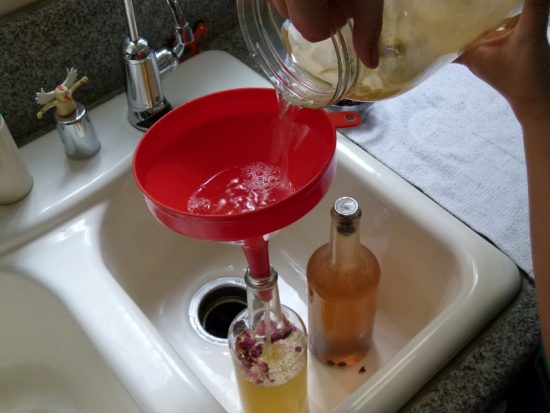
This is how I bottle.
How do I bottle Kombucha?
Bottling Kombucha is a simple process.
In short: recycled glass bottles
- insert a funnel (AMZ) into the neck of your bottle
- add your flavors (optional)
- carefully pour your fermented KT in the bottle
- cap
- wait 1-4 days
- enjoy
If you have a Continuous Brewer, simply hold your bottle under the spigot and use the tap, no funnel required.
What type of bottles should I use?
I recommend using recycled glass bottles (AMZ) or jars with a tight fitting, non-metal lid (if possible). If your brew is particularly active, store the bottles in a cooler or box (AMZ) so that should an explosion occur, the damage and mess will be minimized.
Wine or champagne bottles work as well, with the added benefit that if too much carbonation builds up, the cork will pop out before it explodes the bottle. Messy though! 🙂
Flip top bottles are very popular and look fantastic, but can be pricey.
Plastic is an option. The bottle will harden and swell due to the accumulation of CO2. While Kombucha is tested as safe to use with food grade plastic, plastic bottles should be used only once during the flavoring stage and then recycled.
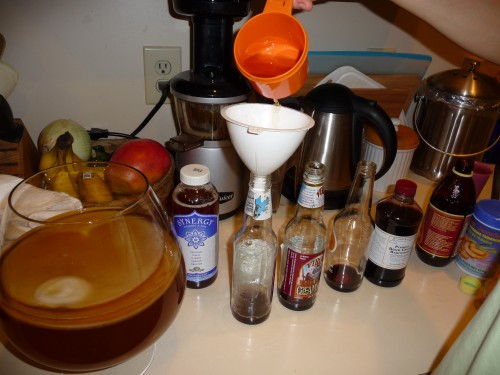
A Very DIY (and awesome!) bottling operation From LovingSuperfoods.com
What flavors do you recommend?
Use your imagination! I recommend using fresh fruit when it is in season, whole or pressed ginger, or fresh herbs (rosemary (THRIVE, AMZ), thyme (THRIVE, AMZ) & sage (THRIVE, AMZ) are nice).
If your Kombucha is too tart to drink, then add garlic (THRIVE, AMZ) and spices to create a healthy vinegar that may be used in marinades or salad dressings.
In the winter, use dried fruit, jam or juice to achieve your fruity flavors. Dried herbs and spices may also be used at anytime.
Want to know more? Check out this Kombucha flavoring video!
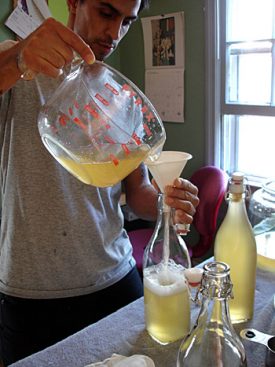
A more exactling (and equally awesome!) Kombucha bottling process by RockingTheStove.com
How much flavoring should I add?
A little bit goes a long way with Kombucha. A good rule of thumb is about ½ tsp – 1 tsp of flavor per 16oz bottle. For more intense flavor, increase the amount used. Experiment and discover your preference.
Can I flavor in anything other than the bottle?
Sure. If you have extra brewing jars, you can flavor right in the jar. First, remove your culture to either a new batch of sweet tea (don’t forget at least a cup of starter liquid – 2 is better – from the top of the current batch) or to your SCOBY Hotel, then add your flavors and screw on the lid.
How long should I leave them to flavor out of the fridge?
I generally recommend leaving your bottles or jars at room temperature for 1-4 days for maximum flavor. Taste daily until the desired flavor is reached, then move them to the fridge to preserve this flavor.
Weather will affect the speed of flavoring as your brew will be more active in warmer months.
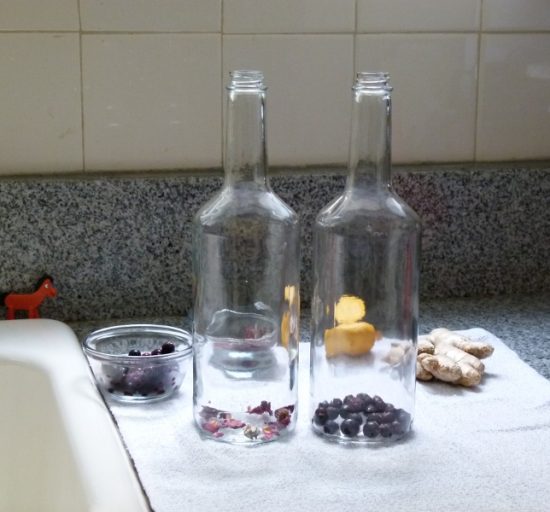
Don’t forget the flavors!
How long will my KT last in the bottle before it goes bad?
Although the fermentation process will continue in the bottle, even with a tight lid, Kombucha never technically “goes bad” or spoils. The pH of the KT is such that it inhibits the growth of other microorganisms.
But the commercial brands have a shelf life?
Does homebrewed KT also have a shelf life?
Kombucha has an indefinite shelf life. Commercial brands are required by law to have an expiration date stamped on them. If you come across a bottle past its date, you may be able to consume it, however depending on how old it is, the flavor may have changed and it may no longer be palatable.
I’ve had bottles of KT age 3-6 months, some more than a year. It definitely changes the flavor as the fermentation process continues in the bottle (bottle conditioning is the term used by beer and wine fermenters to describe this process). Sometimes the results are good, but often it just tastes kind of old and limp is the best I can describe.
Again remember to use caution in where you store the bottles and how often you burp them in order to prevent damage from explosion.
I usually age my bottles out of the fridge, though keeping them in the fridge will cause them to age more slowly.
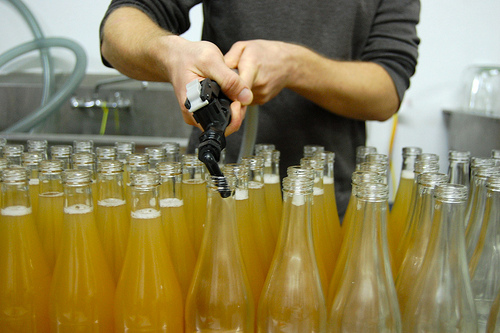
Lonjevitea’s commercial bottling operation
Do I have to put my KT in the fridge?
No! Many people (including me) enjoy the taste of Kombucha at room temperature. Using caution, you may keep your bottles at room temperature indefinitely.
How does bottling increase carbonation?
CO2 is a gas. When we brew our Kombucha, the CO2 is allowed to escape naturally due to the cloth cover. When we put KT into bottles with tight fitting lids, the CO2 gets trapped, which increases the carbonation. This is when burping your bottles becomes important.
What does “burp your bottles” mean?
Why and when should I do this?
Burping your bottles is a recommended step when you are leaving your KT out of the fridge. Slowly unscrew the cap, allow the CO2 to escape, then tightly recap. This will prevent excess CO2 from causing your bottles to explode.
Too much carbonation could cause your bottles to explode. Be safe and store your bottles in a separate box, cupboard or cooler (AMZ) to prevent damage or harm and to contain the mess should an explosion occur. Until you learn how active your brew is, your bottles ought to be burped on a daily basis.
Do I need to filter my brew?
Some people prefer to filter out the brown strands (spent yeast). Adding cheesecloth or a funnel with a strainer to the process makes it easy remove them, otherwise bottle as usual.
I do not filter my brew so that the maximum amount of culture remains in the KT, keeping it alive. However, I generally pour the last bit of brown dregs from the bottom of the bottle down the drain.
Many people drink the yeast as they are a great source of B vitamins, but to each their preference.
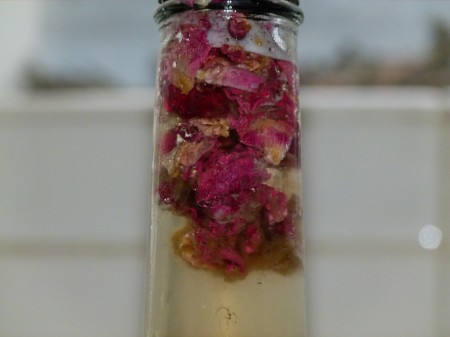
A close up of brown yeast strands mixing with rose petal flavorings in the neck of a Kombucha bottle.
How do I prevent the ooglies from growing in my bottles?
It is near impossible to prevent your Kombucha culture from continuing to grow, even without oxygen. Keeping the bottles in the fridge will slow the growth of new culture, but it won’t necessarily prevent it from occurring. It’s just part of the miracle of Kombucha that it is always making more of itself!
Can I drink the ooglie in my bottle?
Absolutely! Many people believe that the most concentrated form of the healthful acids is present in the culture itself.
I treat an ooglie in my glass or bottle as an oyster shooter; open wide and swallow whole. Gulp!
It isn’t required to eat the ooglie, so if you find it not to your liking, simply dump down the drain or into your compost pile.

John
February 25, 2024 at 4:14 pmDear Hannah , can we use Ozon injection to slow the second fermentation of Kombucha Tea
Hannah Crum
June 12, 2024 at 11:29 amGreat question! Perhaps as I’m not so familiar with using ozone. When commercial Kombucha is force carbonated, the CO2 does help slow the fermentation process by removing the oxygen from the bottle. Assuming the ozone does the same thing, then it would work on the same principle. Let us know how it turns out!
Jerebucha
July 18, 2022 at 12:23 pmAfter reading the various FAQ’s concerning KT bottling options, here are my 2 cents worth after 2 years of using your great Continuous Brew method with your low-end heating strip:
Flip-top bottles are my fave by far for convenience & pressure build-up control. If you have access to a Trader Joe store, look for their Triple Ginger Brew Sparking Beverage. It is naturally=sweetened & flavored and generally can be found in a 25.4 oz green flip-top bottle. Around pumpkin time the bottle switches to brown, indicating “pumpkin spice” flavor. In addition to the wonderful green bottle, its sugar & flavorings are all natural. I use a few ounces of the Ginger Brew, along with 1/2 tsp or so demerara sugar (evaporated cane juice– bought ‘bulk’ from food co-op) when bottling my CB KT into the empty Ginger Brew bottles that i have accumulated through the years. Both the green & the brown 25.4 oz flip-top brews are seasonal, so i stock up when i can. The left-over Ginger Brew can be left in fridge, to be used for bottling the next batch of KT.
Susan
February 26, 2022 at 6:18 amI read that a soda stream can be used to add carbonation. How can that be done, and still use it for regular sodas? Thanks.
Hannah Crum
February 26, 2022 at 6:46 pmHi Susan! We’ve never used a Soda Stream and are therefore unfamiliar with how it works. Let us know what you find out or maybe another reader has some advice to share on this topic. If you need tight fitting lids for your upcycled GT or KeVita type bottles, give these a try – they help to hold in the fizz.
Jane
April 5, 2023 at 4:22 pmThe only way I do it with a soda stream is just carbonate water– soda steam says not to carbonate anything other than plain water– and add it to very strong Kombucha since it will water it down.
Romina
February 4, 2022 at 7:20 amHello hannah,how are you? I bought the big book of Kombucha, and now I want to sell Kombucha bottles.
I have a doubt about bottling and the continuos fermentation of Kombucha.. What can I do to preservet the bacterias and at the same time to stop the fermentation?
Or may be slow down the fermentation process
Greetings
Romina 🙂
Hannah Crum
February 26, 2022 at 6:40 pmCongrats on starting a new Kombucha business, Romina! We love helping new and experienced brands improve their process. Check out our commercial consultation options. There are a few different ways producers use to control fermentation including pasteurization, filtration and refrigeration. We can go into more detail in the consult to figure out which method is best for you and your brand.
Louisa Oneill
June 6, 2021 at 11:37 pmHi my question is , why does commercially produced Kombucha is really really fizzy, also there are never any yeast bits in the bottles. Even the people that claim that theirs is all natural and organic.
Hannah Crum
June 7, 2021 at 11:17 amMany brands both filter & force carbonate to help control ethanol production and to create a more consistent product. Read more about it on our Kombucha Nutritional Label Analysis page.
Sander
March 25, 2021 at 2:26 pmI can confirm that KT never really goes bad. I still have plenty of bottles left from when I used to brew that stuff. I bottled in champagne bottles with crown caps and the oldest bottles have been stored for like 7 years at room temperature. I opened a bottle today and the taste was pretty much the same as it was 6-7 years ago!!
Valentine Peneha
March 19, 2020 at 5:23 pmThank you. Got a lot of info that I never new. So stoked to learn what I have learnt. Again thank you
Perry
December 8, 2019 at 6:58 pmI would like to know how to bottle my KT as teh professional ones and keep it fresh in room temperature for long time?
Hannah Crum
December 7, 2023 at 2:07 pmSure! We offer commercial consultations for those who want to turn their love of Kombucha into a business –> Commercial Kombucha Brewing Consultation or check out our Side Hustle Class
Loïc
October 30, 2019 at 11:51 amHello,
I switched from flip top to crown cap and I now find small ooglies in my bottles. I am wondering if it does not come from the fact that the seal is not airproof enough. With the flip top I do not have this issue. What do you think ?
Hannah Crum
November 4, 2019 at 8:55 amAgreed – one remedy would be to fill the bottles to the tippy top to reduce airspace – or go back to swing tops…
Loïc
November 13, 2019 at 1:26 amWhat about doing some filtering to reduce the yeasts or add co2 ?
Hannah Crum
November 18, 2019 at 9:21 amYes, you may do that as well. Filtering the yeast also means a less round flavor as filtered Kombucha is much drier and some of the nutritional value is also minimized as the yeast contain B vitamins in trace amounts. Adding CO2 is an option and some homebrewers will use a Soda Stream to do so.
NOMI
January 20, 2020 at 1:02 pmWhat about adding some sulphur? I know someone who manufactures wines from fermented plants, yeasts and sugar and he uses trace of sulphur to stop fermentation.
Hannah Crum
February 13, 2020 at 2:36 pmI believe they use “sulfites” not actual sulphur. We prefer to keep our booch preservative free. Keep in mind, some people are sensitive to sulfites as well.
Rita
September 30, 2019 at 8:45 pmhi there! I I didn’t have enough empty bottles for my 2nd fermentation (I made a lot of your Jun a few days before). So, I decided to store all of my first fermentation in the refrigerator so that it doesn’t turn too vinegar-y.
Do you think I could bottle that refrigerated first fermentation of Kombucha in a few days (when I have enough empty bottles available) to carbonate and infuse with fruit? I’m hoping to make a fizzy Kombucha in the second fermentation. Note that I usually add 30 raisins & about 20-40 grams of a fruit to the second fermentation – bottle is about 32 ounces).
Thank you!
Hannah Crum
October 1, 2019 at 4:23 pmSure there’s no reason it won’t work, but there’s no way to know until you try. It’s all based on taste as you know, so as long as you like the result it’s a success! 🙂
Rita
October 2, 2019 at 6:44 pmOK! I’m having a go at it … just bottled them. I’ll report back to share if I felt like it worked (fizzy carbonation) or if the batch remained more like the first fermentation without carbonation. Thank you!
Rita
October 9, 2019 at 8:59 pmOkay, so I tried it and it did in fact carbonate! Success! It was in F2 for about 3 or 4 days … three our of the four bottles were VERY fizzy, the strawberry was fizzy but not as wildly fizzy as the others (ginger, raspberry, and raspberry/strawberry). Thank you!
karen mason
December 26, 2018 at 9:41 amcan I use refrigerated acai berry juice to second ferment and is it ok to not refrigerate it ?
Hannah Crum
January 4, 2019 at 7:30 amYes! It can be frozen, fresh, refrigerated or dried!
Stephanie Cruson
November 5, 2018 at 8:44 pmHello,
Can I use square bottles to bottle my Kombucha? Seems like I read somewhere you shouldn’t but I can’t remember where I saw that.
Hannah Crum
December 1, 2018 at 1:06 pmYes – any shape bottle will do – keep in mind that the thicker the glass, the higher the pressure it can withstand (think champagne bottle glass vs wine bottle glass).
Matthew Brown
October 12, 2018 at 8:10 amIf I bottle my booch without any added flavor will it continue to get more fizzy?
Hannah Crum
December 1, 2018 at 1:08 pmIt can if there is enough residual sugar and some yeast strands in the bottle. You can also add 1-2 raisins or a 1/4 tsp of sugar per 16oz bottle as “priming sugar” to create additional fizz.
Karen
June 10, 2018 at 10:10 amDo I need to do any special prep to my flip top bottles before I use them to bottle my CB? Can I just wash with dish soap or do I need to do a vinegar rinse like with the vessel? Getting ready to bottle my first batch!!
Hannah Crum
June 15, 2018 at 10:07 amAs long as the bottles are clean and free from debris, they are ready to use. Some will do a vinegar wash just to make sure all of the soap is rinsed away – totally up to you!
Heidi
June 5, 2018 at 9:31 amWhat keeps my vinegar that I buy at the store (with a mother) from building up gas and breaking the bottle?
Hannah Crum
June 28, 2019 at 3:16 pmOften its pasteurized. If its raw, the sugars have already been converted to acetic acid which is why no fizz.
DEBORAH A MARTINEZ
May 31, 2017 at 8:35 amhello my Kombucha never gets fizzy i would like it to stay that way but does that mean the tea is bad?
Hannah Crum
May 14, 2018 at 1:32 pmCheck out this post here for more ways to make your Kombucha fizzy –> https://www.Kombuchakamp.com/Kombucha-carbonation-for-beginners
Prisilla
September 12, 2016 at 9:38 amI am working on Strawberry and Basil Kombucha now. I have it in 2 bottles one an old cork top moonshine bottle and the other is a plastic screw top Chambord bottle. Putting it in a box is a great idea to prevent messes thank you!!!
Cheryl
June 26, 2016 at 10:16 pmTo Tonna, I had an antique bottle with all kinds of gunk in the bottom and I used a couple handfuls of small rocks and some white vinegar and shook like crazy and then rinsed well with hot water. It came out sparkling clean.
Tonna
July 8, 2015 at 8:49 pmI am on my third batch of booch using flip top bottles for second ferment, but I cannot for the life of me find a bottle brush that will fit inside the neck, clean all the way to the bottom, and onto the curved area under the neck of the bottle. I have some residue left on the bottles from the yeast or fruit sticking to the sides that will not come off. I’ve tried boiling the bottles, and the old waitress trick with salt and water, but still won’t come clean. I didn’t see anything like that on your site or at specialty stores either. Any advice?
Hannah Crum
July 9, 2015 at 7:09 pmTry a brewery shop online – they carry all sizes of bottle brushes.
Debbie
March 10, 2019 at 6:55 amI also brew Beer & Wine – Try using a “Carboy Brush” (looks like a bent bottle bush) ~ it is constructed with a bend in it to reach those areas Tonna speaks of. Also… the brush “seems” to big to go into the opening – give it a shove. It will go in and clean your bottle – I’d still be weary of wth that “gunk” is … just sayin’
Angela
June 9, 2015 at 11:47 pmI literally googled “oyster in my Kombucha” and found this page, that’s exactly what it was like! An oyster shooter.
Lori Frisone
April 6, 2015 at 2:53 pmI added fresh raspberries to a bottle for second fermentation and a few days later when I went to drink it, it smelled like sulphur! Any info on that?
Also, just wanted to share that one of my favorite flavors that I have come up with is adding Star Anise to the KT for second fermentation.
Thanks
Lori
Hannah Crum
April 8, 2015 at 11:16 pmSome fruits are very high in sugar and that can over excite the yeast which can manifest in a sulphury smell. It is still safe to drink but you might just want to toss it if it doesn’t taste good. Trust YOUR gut! Mmmm – star anise is great alone or with other spices too.
Jan Nirri
May 13, 2014 at 12:58 pmHi Hannah.
OK. I have spent the past hour on your site searching for answers to the chemical taste I have in my continuous brew. I am understanding now that it’s probably acetone. So, I did a search on your site for acetone and some stuff comes up but when I click on those I am sent to a page where i can’t for the life of me find where it’s talking about acetone. I don’t like the taste and I’m assuming that something is out of balance. I have harvested 2 scobys out of my continuous brew so far and they are tucked away in a hotel 🙂 A new scoby formed on the top (and it’s beautiful) but the other one (from KK) is sitting on the bottom (doesn’t it need to “breathe”?). The tea is so cloudy that I can’t tell if there are any yeast strands hanging from the scoby at the top. I have a white with black spots sediment forming on the bottom of this continuous brew. Of course the spout is at the bottom of this glass container.
I drank some of this booch the other evening but the taste was so bad I dumped it out… was a bit worried I’d get sick from it… but happily no ill-effects. 🙂 I’m wanting to share my booch and flavoring experiments with friends but this new development is keeping me from using it at the moment. I’d really appreciate your insight!
Hannah Crum
May 23, 2014 at 3:45 pmAcetone flavors are typically created by yeast when they don’t have access to oxygen. Are you using a cloth cover to allow it to breathe? The cloudiness is likely yeast strands – they don’t always clump into globs. The SCOBY at the bottom of the vessel is fine – the mother can live anywhere and the new layers always grows across the top.
Ensure you are getting good airflow and the SCOBY isn’t too thick and that should yield a better tasting brew.
El
January 23, 2014 at 6:56 pmIf my Kombucha was bottled and refrigerated, then taken out of the ‘frig and kept at 60-65 degrees for 3 weeks, then 75-80’ for 2 days…is it still okay to drink? There seems to be no pressure on the caps of the regular or fruit flavored ones, but a bottle of one made with chia seeds, blew the cap off forcefully when I opened it. I re-refrigerated them all. Are they okay to drink, and should I be burping them all everyday in the ‘frig? What is an indication that I should not drink it?
Hannah Crum
February 3, 2014 at 3:24 pmKombucha never “goes bad” in the same way that processed foods do. What that means is that it can be stored indefinitely. Now, it will continue to ferment in the bottle and the flavor will continue to change over time, so when you go to taste the Kombucha, that is how you will decide if you want to drink it or not.
Myrna Magandy
January 5, 2014 at 11:41 amCan you please explain what metal does to Kombucha? Is it harmful? Does it decrease its effectiveness?
Thank you!!
Hannah Crum
January 5, 2014 at 9:04 pmKombucha is a powerful detoxifyer. Metals are sometimes composed of elements that can be harmful to the human body – i.e. lead or aluminum. So if we brew in vessels not appropriate for making Kombucha, it may leach those harmful elements into the KT and when consumed could have a negative effect. Stainless Steel 304 grade and higher is safe to use for brewing Kombucha because it is corrosive resistant and is also used in the beer and wine industry.
Incidental contact with a metal funnel or spoon likely won’t be an issue because it is for a brief period of time that the KT is in contact with the metal.
Marianne
September 24, 2013 at 10:43 amMy question is about bottling and burping the bottles. I am new to this and want to understand the process. I have ordered the flip top bottles. I plan to brew the KT then do a secondary fermentation (I like a little fiz and want to replicate some store bought flavors I like). So, Brew, Bottle and flavor with flip top bottle, Three days (in a protected box). Then refrigerate. Question: Do I need to burp the bottles during the three day secondary fermentation? Once in the refrigerator is there a risk of bottles exploding? If I burp the bottles will I not have any fiz? Thanks for your help!
Marianne
September 24, 2013 at 12:04 pmI have another question: Can I secondary ferment (with flavors) in a large jar and then bottle after the 3 days. Will the flavored Kombucha still be fizzy or is the only way to make if fizzy to secondary ferment it in the smaller sealed bottles?
Hannah Crum
September 24, 2013 at 6:03 pmThat is a great way to flavor. If the jar is open, the CO2 will evaporate into the atmosphere since it is a gas. That is why bottling works to create carbonation because it holds in the CO2.
Hannah Crum
October 23, 2013 at 6:56 amOnce in the fridge, there won’t be a need to burp the bottles because the yeast is temperature sensitive. You may want to monitor them during 2F because we have reintroduced sugar to the yeast in an anaerobic environment (with the lid on) and that is when they make CO2. If you over burp your bottles, you run the risk of letting all the CO2 out and ending up with flat KT. Balance is key!
Howard Wilkinson
June 6, 2013 at 8:10 pmI’m wondering about using a two stage fermentation process. Ferment to the desired PH, then put a tight lid on with a fermentation lock and allowing the yeast to ferment out the remaining sugar………or vice versa. If you ferment out the sugar entirely… as with beer, then the bottling sugar should produce a predictable pressure and carbonation. Any thoughts? The two stage process could be done in the same container.
Hannah Crum
June 18, 2013 at 1:03 amProvided you have a tight fitting lid for that vessel, then yes, you certainly could keep it in the same vessel. Most folks move it to bottles to help keep the CO2 in the booch.
Judy Morris
April 28, 2013 at 1:46 pmWhen you covered bottling in your manual, nothing was said about sanitizing the bottles. Should they be boiled or just washed and rinsed well?
Hannah Crum
April 28, 2013 at 10:43 pmBottles should be washed prior to use. We recommend using vinegar & hot water.
Bryan
April 15, 2013 at 9:12 pmIn your book you mention to bottle without using metal lids/caps, but I’m curious whether you’ve had (or heard of) success using sanitized beer bottles and re-capping them? I homebrew beer as well, so I always have bottles and caps, and was planning on bottling booch with pop-off caps, but I’m pausing due to your no-metal comments. They do have oxygen-absorbing caps for high-alcohol beers, maybe that’d work? Any advice? Or should I go buy some Grolsch instead and use those? (not that enjoying a few pints of Grolsch is an inconvenient chore…)
Hannah Crum
April 16, 2013 at 9:29 amThe Grolsch bottles work great. I believe the beer caps have a lining so that it isn’t metal on the glass. Also, if you store them upright, the Kombucha won’t be touching the cap. We have Swing top bottling kits available as well.
Amy Rood
March 3, 2013 at 9:11 pmI am having trouble getting my Kombucha to fizz in my flip-top bottles. I have tried batch after batch, in various climates, for varying lengths of time. Nothing changes, nothing works. Any pointers or tips?
Thanks!!
Hannah Crum
March 7, 2013 at 12:05 pmAdding priming sugar or fruit (which has natural sugar) will reactivate the yeast. If you are doing CB, then stir the KT gently before decanting to get yeastie bits in your bottles. Do NOT filter your brew if you do not have enough carbonation as you will remove the yeast which makes the CO2.
kev
January 6, 2013 at 9:46 amginger and blueberry
Gretchen
December 27, 2012 at 6:27 amI am interested in brewing on a larger scale. Any tips? Our town needs some local booch. Thanks. P.S. The SCOBY I got from you was great!
Hannah Crum
January 2, 2013 at 10:07 pmWe offer consultation services for those wishing to scale up or to get into the bottled Kombucha market. Drop a line to customerservice@Kombuchakamp.com for more details.
Donna DeLong-Pugliese
April 7, 2023 at 5:53 amMy Kombucha doesn’t seem to very carbonated, sometimes I just get small psst. I am using store bought bottles with screw tops, I also use some flip top bottles. What am I doing wrong?
Anthea Tayag
April 7, 2023 at 9:42 amThere are many factors that could contribute to little to no fizz in the brew. We suggest stirring up the yeast so that it gets included into the bottle, doing a 2nd ferment, or letting the bottled Kombucha ferment a little longer on the counter. For more information, please review our blog post on carbonation
Tony
September 16, 2012 at 5:26 pmHello, I am new to brewing and have been doing continuous brewing for about a month. I am bottling my brew in EZ cap bottles with about 1 1/2 tspn of sugar (1 liter bottles). I have read that if bottles of Kombucha are sealed Acetone could be produced, is all Acetone harmful and do you have any info on this ?
Thanks, Tony
Hannah Crum
September 19, 2012 at 4:12 pmAcetone is a normal by-product of fermentation and may be present in small amounts in Kombucha. These small amounts are not harmful. If your Kombucha smells like acetone, then it may have been contaminated with a foreign bacteria – in which case you would want to dispose of that batch.
annalee
August 19, 2012 at 8:22 amU r just the coolest and the best. As an “aging” 26 year old dancer in nyc…… Kombucha literally changed my life. My hair, skin, and even depression have been so improved. Im saving $ to buy a continuous brewer….. But even with my gallon pickle jars (i enjoy the process…..I just need more continuous supply) I have saved so much money n EVEN LIKE MY KOMBUCHA MORE! Until then I was just wondering, as the winter approaches…. Do u think I need to use a heating pad on the.shelf? That’s what I did oinitially but then it got warm……. Now I have jars everywhere as my knowledge n confidenc grew…….b ut. I only have so many heating pads as winter approaches…haha….any particular pointers for cold weather brewing? I refuse to return to coffee n red bull! Thank u so much! Love to u and all fellow brewers!
lisa
August 3, 2012 at 11:30 pmHi Kombucha Mama,
Can I use refrigerated Kombucha as a starter liquid for a future batch?
Thanks Lisa
Hannah Crum
August 7, 2012 at 8:07 amBest to use starter out of your SCOBY Hotel. It will be quite strong, so you won’t need as much. Then, top off your SCOBY Hotel with fresh sweet tea to keep your SCOBYs happy!
Shawna Hudson via Facebook
July 9, 2012 at 2:32 pmWhat should I do with my 2 gallons of “super-booch”???
Sherry Morris via Facebook
July 9, 2012 at 10:34 amseriously need to bottle a couple gallons today…or it is going to turn into super-booch!
Yolie
April 15, 2012 at 10:20 amOnce the Kombucha reaches the 3.0 pH does and it is ready, you can drink or bottle…correct? and if you bottle it does the pH change after bottling?…Do I need to recheck it after?
hannah
April 16, 2012 at 3:12 pmThe pH is an important indicator that your brew is protected from invasion by other microorganisms, however, it does not indicate that the Kombucha is ready to be consumed. Taste is king – allow your taste buds to tell you when enough sugar has fermented out of it. The sweeter the brew, the more sugar it contains.
Zoe
May 10, 2011 at 2:48 pmThe 1st batch of KT that I brewed for 10 days, I bottled into 10 flip-top bottles and waited watchfully for a week as they sat at room temp (approx 68 degrees) before reluctantly refrigerating 5 of them with no fizz present. The other 5 sat for another 10 days or so at room temp. I took the risk of not burping them at all for about 7 days. Three of those five finally had fizz and after 3 more days the last 2 acquired sufficient fizz. I refrigerated the fizzy ones only to consume them as soon as they were cold enough for my liking. They were flavored and they were DELICIOUS!
My question is…
The first 5 (non-fizzy) bottles of KT have now been in my fridge for about 3 weeks now. They still do not have fizz. If I allowed them to sit out at room temp again for awhile, what would/could happen? I just want to know if there is anyway to reclaim the opportunity to carbonate those chilled bottles.
hannah
May 10, 2011 at 9:10 amHi Courtney, If that happens again, you can let the foaming KT overflow into a pitcher and recapture some of your brew. Placing your bottles in the fridge will calm some of the carbonation too.
Kombucha Kamp via Facebook
May 10, 2011 at 9:07 amHmmm…let me put on my thinking cap and see what I can come up with…
Vanessa Tortolano via Facebook
May 10, 2011 at 9:06 amgot any leads on where to get an actual bottling machine??
Cortney
May 10, 2011 at 8:24 amI have the flip top bottles. I’ve made two batches that we couldn’t drink, all 12 bottles wouldn’t stop fizzing after they were opened and the first bottle shot it’s contents onto my ceiling 🙂 The first batch sat for 7 days(way too long) and the second batch sat for 2 days. I didn’t know about burping!! My poor scoby has been sitting there waiting. I guess I’ll start some new brew and try again, this time remembering to burp!